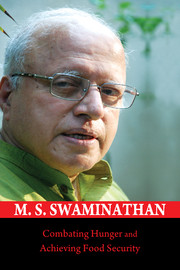Book contents
- Frontmatter
- Contents
- Foreword
- Preface
- Acknowledgements
- Abbreviations
- 1 Genesis and Growth of the Yield Revolution in Wheat
- 2 Our Agricultural Heritage
- 3 Shaping Our Agricultural Destiny
- 4 Thrust on Farm Revival
- 5 Nutri-farm Movement
- 6 Nutrition-sensitive Agriculture
- 7 Food Losses and Food Waste
- 8 Rice in Zero Hunger Challenge
- 9 Monsoon Management
- 10 Importance of Ecological Conservation
- 11 Caring for Ecology and Heritage
- 12 Conserving Biodiversity
- 13 Overcoming Hidden Hunger through Aquaculture
- 14 Biofuels – The Way to Go
- 15 Food Security
- 16 Vigilance for Sustainable Food Security
- 17 Food Security and Social Protection
- 18 Food Security and its Role
- 19 Sustaining the Livestock Revolution
- 20 Challenges in the Year of Science
- 21 Agriculture and Humanism
- 22 Fostering the Science of Science Communication
- 23 Olympic Move for Saving Children
- 24 Youth: The Agents of Change
- 25 Role of Women in Agricultural Production
- 26 Know-how to Do-how
- 27 From Bengal Famine to Right to Food
- 28 Financial Institutions and Fighting Food Inflation
- 29 Public Good Research in Agriculture
- 30 The Future of Indian Agriculture
- Bibliography
26 - Know-how to Do-how
Published online by Cambridge University Press: 18 December 2015
- Frontmatter
- Contents
- Foreword
- Preface
- Acknowledgements
- Abbreviations
- 1 Genesis and Growth of the Yield Revolution in Wheat
- 2 Our Agricultural Heritage
- 3 Shaping Our Agricultural Destiny
- 4 Thrust on Farm Revival
- 5 Nutri-farm Movement
- 6 Nutrition-sensitive Agriculture
- 7 Food Losses and Food Waste
- 8 Rice in Zero Hunger Challenge
- 9 Monsoon Management
- 10 Importance of Ecological Conservation
- 11 Caring for Ecology and Heritage
- 12 Conserving Biodiversity
- 13 Overcoming Hidden Hunger through Aquaculture
- 14 Biofuels – The Way to Go
- 15 Food Security
- 16 Vigilance for Sustainable Food Security
- 17 Food Security and Social Protection
- 18 Food Security and its Role
- 19 Sustaining the Livestock Revolution
- 20 Challenges in the Year of Science
- 21 Agriculture and Humanism
- 22 Fostering the Science of Science Communication
- 23 Olympic Move for Saving Children
- 24 Youth: The Agents of Change
- 25 Role of Women in Agricultural Production
- 26 Know-how to Do-how
- 27 From Bengal Famine to Right to Food
- 28 Financial Institutions and Fighting Food Inflation
- 29 Public Good Research in Agriculture
- 30 The Future of Indian Agriculture
- Bibliography
Summary
India is poised for a major information and communication technology (ICT) revolution in the rural areas. The broad strategy proposed by the National Commission on Farmers (NCF), which I chaired, is the following:
• Establishment of a village resource centre (VRC) in every block with the help of the Indian Space Research Organisation. These VRCs will be linked to satellites and will have telecommunication facilities.
• Every panchayat headquarters will have a gyan chaupal or Village Knowledge Centre (VKC). These will have internet connectivity. Alternatively, the gyan chaupal can be established in the village school or any other public space where there will be social inclusion in access to the technology.
• The last mile and last person connectivity will be through FM/community radio and/or mobile phones. The internet–radio–mobile phone synergy is a very powerful tool for social inclusion in access to all the needed information, including warning of impending natural disasters. Villagers give priority to health and marketing information. In addition, an entitlements database can empower them with information on all the government schemes designed for their well-being. Gender- specific information is equally important. Every farmer in the village should be issued an Entitlements Pass Book. Artisanal fishermen can now be assisted with a cell phone, which can provide GPS data on wave heights and location of fish shoals.
NCF has recommended the following steps to bridge the prevailing know-how: do-how gap:
• Promote farmer-to-farmer learning by establishing farm schools in the fields of outstanding farmer-achievers.
• Revitalize and upgrade KVKs (farm science centres) by adding a post-harvest technology wing.
• Organize 60,000 lab-to-land demonstrations in the areas of post-harvest processing, marketing and value addition to primary produce all over the country.
• Establish gyan chaupals in every village based on the integrated use of the internet, cable TV, community radio, cell phone and local language community newspapers.
• Establish capacity building centres for those operating gyan chaupals.
• Train one woman and one male member in every panchayat as farm science managers, with particular reference to genetically modified crops.
• Establish at the district level a self-help group (SHG) training and mentoring centre, in order to build a local level cadre of SHG catalysts, capable of organizing sustainable livelihood banks based on micro-credit.
• Establish in coastal areas fish for all training centres to provide training in all aspects of fisheries, ranging from capture/culture to consumption.
- Type
- Chapter
- Information
- Combating Hunger and Achieving Food Security , pp. 141 - 144Publisher: Cambridge University PressPrint publication year: 2016



